Pets Design: Difference between revisions
No edit summary |
|||
| (22 intermediate revisions by one other user not shown) | |||
| Line 1: | Line 1: | ||
= Functional Design = | = Functional Design = | ||
The Functional Design show the functionality of the Pet system. | |||
== States == | == States == | ||
This is the states that a pet can be in. | |||
<uml> | <uml> | ||
[*] --> Dismissed : create_familiar | [*] --> Dismissed : create_familiar | ||
Dismissed --> Summoned : /pet summon | Dismissed --> Summoned : /pet summon | ||
Dismissed : Reset pet elapsed time | |||
Summoned --> Depleted : max time reached | Summoned --> Depleted : max time reached | ||
Depleted --> Dismissed : depleted lockout over | Depleted --> Dismissed : depleted lockout over | ||
Summoned --> Dead: killed | Summoned --> Dead: killed | ||
Dead --> Dismissed : death lockout over | Dead --> Dismissed : death lockout over | ||
Summoned --> Dismissed : /pet | Summoned --> DismissedResting : /pet dismiss | ||
DismissedResting --> Dismissed : dismiss lockout over | |||
DismissedResting --> Summoned : /pet summon | |||
state "Dismissed resting" as DismissedResting | |||
state Summoned { | state Summoned { | ||
| Line 31: | Line 39: | ||
</uml> | </uml> | ||
=== Dismissed resting === | |||
When dismissed the pet will be in a state where if resummoned the time lived will not be reset. After the DismissedLockoutTime the time lived is reset to 0. This penalty has to be taken either before logout or before summoning after login. | |||
= Physical Design = | = Physical Design = | ||
In the Physical Design the different parts of the functional design is allocated to different systems. Some are handled server side, other at the npcclient. Some in code and others in scripts. | |||
== Database == | |||
<uml> | |||
class character << (D,orchid) >> { | |||
+id | |||
+animal_affinity | |||
+pet_elapsed_time | |||
} | |||
class familiar_types << (D,orchid) >>{ | |||
+id | |||
+name | |||
+type | |||
+lifecycle | |||
+attacktool | |||
+attacktype | |||
+magicalaffinity | |||
+vision | |||
+speed | |||
+hearing | |||
} | |||
class char_create_affinity << (D,orchid) >>{ | |||
+attribute | |||
+category | |||
} | |||
class character_relationships << (D,orchid) >>{ | |||
+character_id | |||
+related_id | |||
+relationship_type | |||
+spousename | |||
} | |||
note right of character_relationships | |||
Relationship_type can be: | |||
*familiar | |||
*buddy | |||
*spouse | |||
*exploration | |||
end note | |||
character "2" -- "0..n" character_relationships : > | |||
</uml> | |||
== Classes == | == Classes == | ||
| Line 49: | Line 110: | ||
NPCManager "1" *-- "many" PetOwnerSession : ownerPetList | NPCManager "1" *-- "many" PetOwnerSession : ownerPetList | ||
class psFamiliarType { | |||
-id | |||
-name | |||
-type | |||
-lifeCycle | |||
-attackTool | |||
-attackType | |||
-magicalAffinity | |||
} | |||
class EntityManager { | |||
} | |||
EntityManager "1" *-- "many" psFamiliarType : familiarTypeList | |||
class psCharacter { | |||
-animalAffinity | |||
-ownerId | |||
-familiarsId[] | |||
-canSummonFamiliar | |||
+UpdatePetTime() | |||
} | |||
class gemActor { | |||
} | |||
class gemNPC { | |||
} | |||
gemNPC *-- gemActor : owner | |||
note on link | |||
Rely to a gemObject but that | |||
doesn't say much. So we use | |||
the gemActor. | |||
end note | |||
gemActor *-- psCharacter : psChar | |||
</uml> | |||
== Activities == | |||
=== Create === | |||
<uml> | |||
(*) --> "Activity" | |||
--> (*) | |||
</uml> | </uml> | ||
== Sequences == | == Sequences == | ||
=== Create === | |||
<uml> | |||
->> CreateFamiliarOP : Run | |||
activate CreateFamiliarOP | |||
CreateFamiliarOP ->> EntityManager : CreateFamiliar | |||
activate EntityManager | |||
EntityManager ->> psCharacter : GetMasterFamiliarID | |||
activate psCharacter | |||
EntityManager <<-- psCharacter | |||
deactivate psCharacter | |||
EntityManager ->> EntityManager : CopyNPCFromDatabase | |||
activate EntityManager | |||
deactivate EntityManager | |||
EntityManager ->> EntityManager : CreateNPC | |||
activate EntityManager | |||
create gemNPC | |||
EntityManager ->> gemNPC | |||
deactivate EntityManager | |||
EntityManager ->> gemNPC : SetOwner | |||
activate gemNPC | |||
deactivate gemNPC | |||
EntityManager ->> Client : SetFamiliar | |||
activate Client | |||
deactivate Client | |||
EntityManager ->> psCharacter : SetFamiliarID | |||
activate psCharacter | |||
deactivate psCharacter | |||
EntityManager ->> NPCManager : AddEntity | |||
activate NPCManager | |||
deactivate NPCManager | |||
EntityManager ->> NPCManager : ControlNPC | |||
activate NPCManager | |||
deactivate NPCManager | |||
EntityManager ->> NPCManager : CreatePetOwnerSession | |||
activate NPCManager | |||
create PetOwnerSession | |||
NPCManager ->> PetOwnerSession | |||
EntityManager <<-- NPCManager | |||
deactivate NPCManager | |||
deactivate psCharacter | |||
CreateFamiliarOP <<-- EntityManager | |||
deactivate EntityManager | |||
<<-- CreateFamiliarOP | |||
deactivate CreateFamiliarOP | |||
</uml> | |||
=== Death === | === Death === | ||
| Line 84: | Line 250: | ||
deactivate NPCManager | deactivate NPCManager | ||
SpawnManager -\\ : psDespawnGameEvent | SpawnManager -\\ : psDespawnGameEvent | ||
deactivate SpawnManager | |||
deactivate SpawnManager | deactivate SpawnManager | ||
... DeathRemainTime ... | ... DeathRemainTime ... | ||
| Line 89: | Line 256: | ||
activate SpawnManager | activate SpawnManager | ||
SpawnManager ->> SpawnManager : RemoveNPC | SpawnManager ->> SpawnManager : RemoveNPC | ||
activate SpawnManager | |||
deactivate SpawnManager | |||
deactivate SpawnManager | deactivate SpawnManager | ||
... Some time ... | ... Some time ... | ||
| Line 102: | Line 271: | ||
=== PSUnreal === | |||
Ideas for Pets | |||
Specific new information needed, will be stored in character_variables table associated to the pet: | |||
* Energy | |||
* Happiness | |||
* Last time fed | |||
Other fields used, but already available in the current database structure: | |||
* Exp (available) | |||
* Inventory (available) | |||
* Knowledge area to speak (available) | |||
For the Pet evolution and associated abilities we need to add two new tables: | |||
* Pet Evolution table: ID, Name, size_scale, mesh_name, exp_required | |||
* Pet Abilities table: evo_stage_id, name, pet_command, storage | |||
where pet_command will determine access from the player to the specific command in the list below: | |||
/pet learn location forest | |||
/pet learn target Trepor | |||
/pet go location forest | |||
/pet go position 100 f | |||
/pet learn phrase Hello my name is... | |||
/pet learn answer "what is your name" "my name is xyz" | |||
/pet scout creatures <range?> | |||
/pet scout items <range> | |||
/pet grant yes/no <name> | |||
/pet scout traps <range?> | |||
/pet scout hidden <range?> | |||
/pet distract <target> | |||
/pet senses sight | |||
To evolve your pet, you will give him food, which is providing energy, energy allows to execute tasks/abilities, this is increase the experience of the pet and the empathy of the owner, and at certain level of experience the pet evolves to a new stage. | |||
Food -> Energy -> Abilities -> Exp/Empathy -> Evolution stage | |||
[[Category:Engine documents]] [[Category:Server Design]] | [[Category:Engine documents]] [[Category:Server Design]] | ||
Latest revision as of 17:47, 28 February 2021
Functional Design
The Functional Design show the functionality of the Pet system.
States
This is the states that a pet can be in.
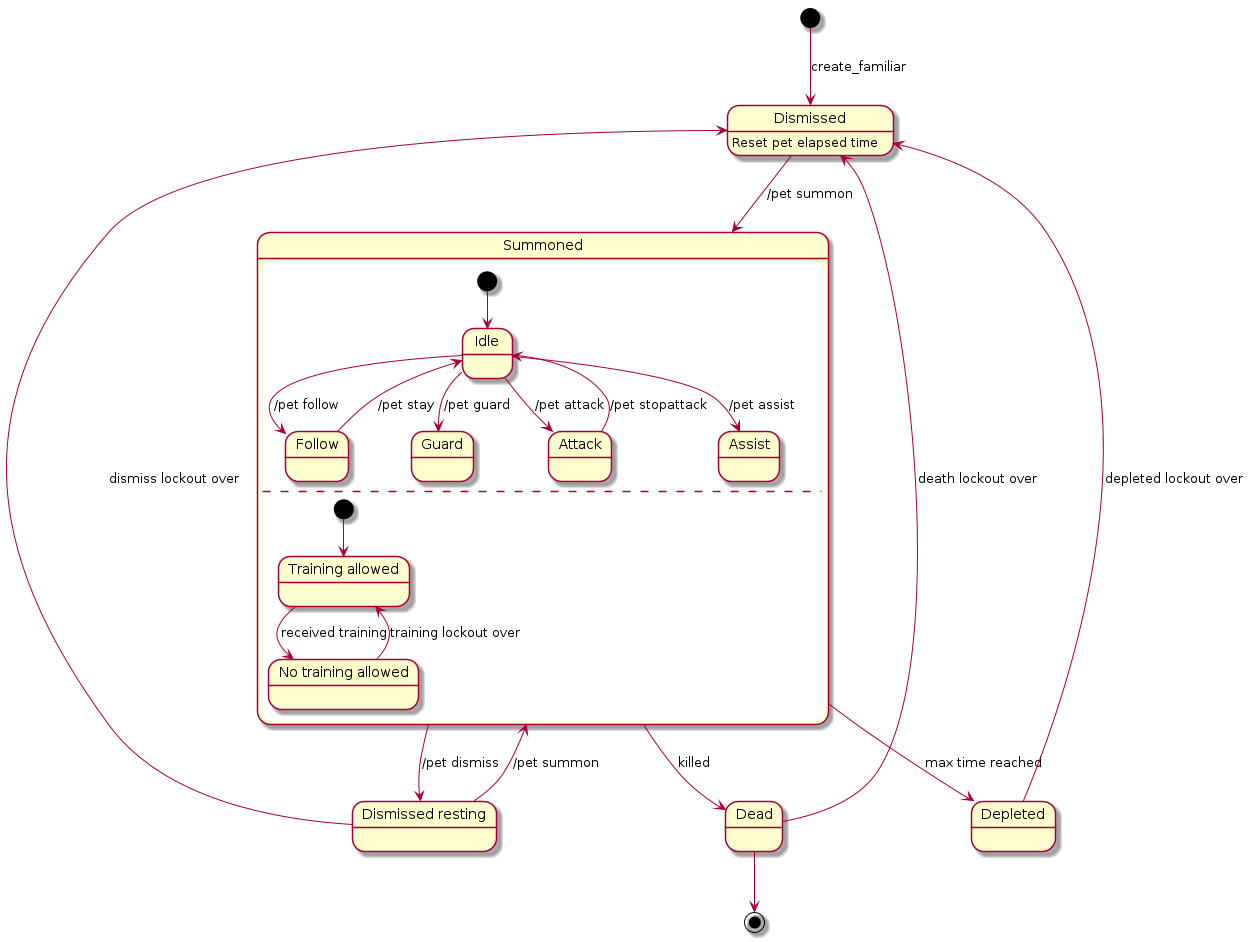
Dismissed resting
When dismissed the pet will be in a state where if resummoned the time lived will not be reset. After the DismissedLockoutTime the time lived is reset to 0. This penalty has to be taken either before logout or before summoning after login.
Physical Design
In the Physical Design the different parts of the functional design is allocated to different systems. Some are handled server side, other at the npcclient. Some in code and others in scripts.
Database
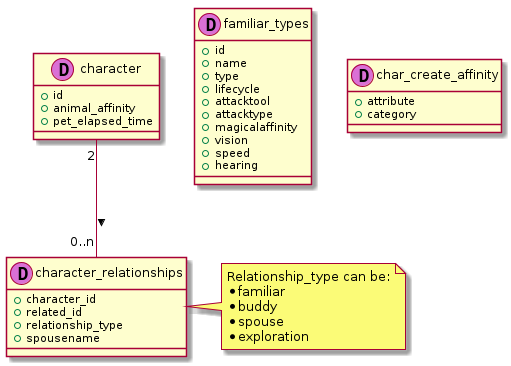
Classes
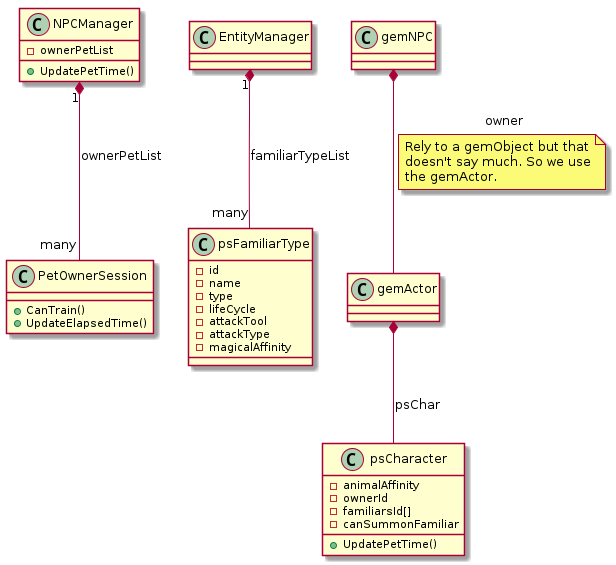
Activities
Create

Sequences
Create
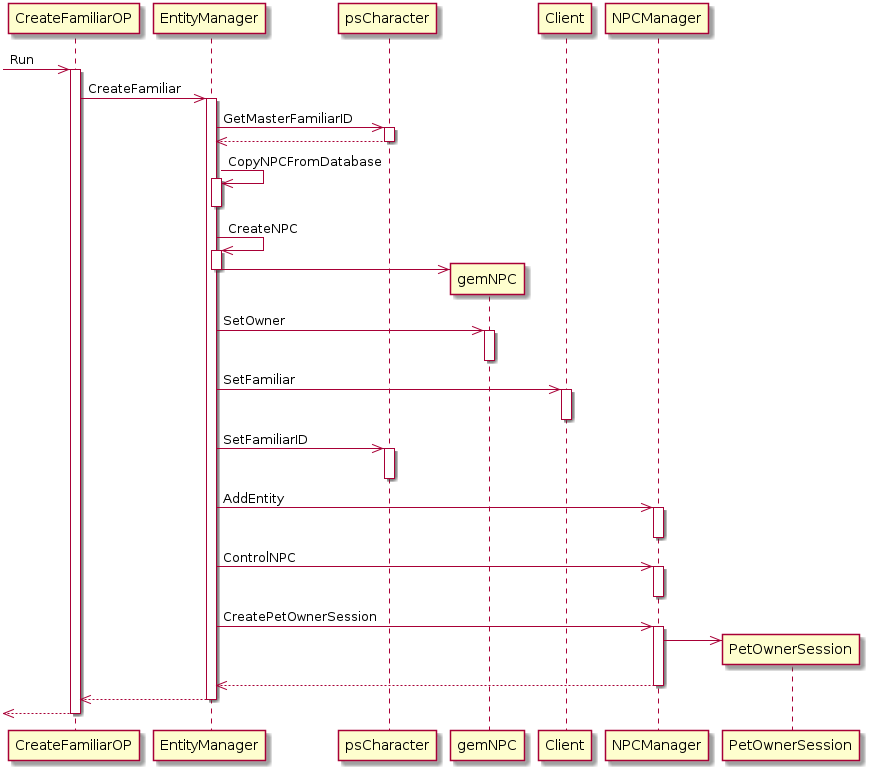
Death
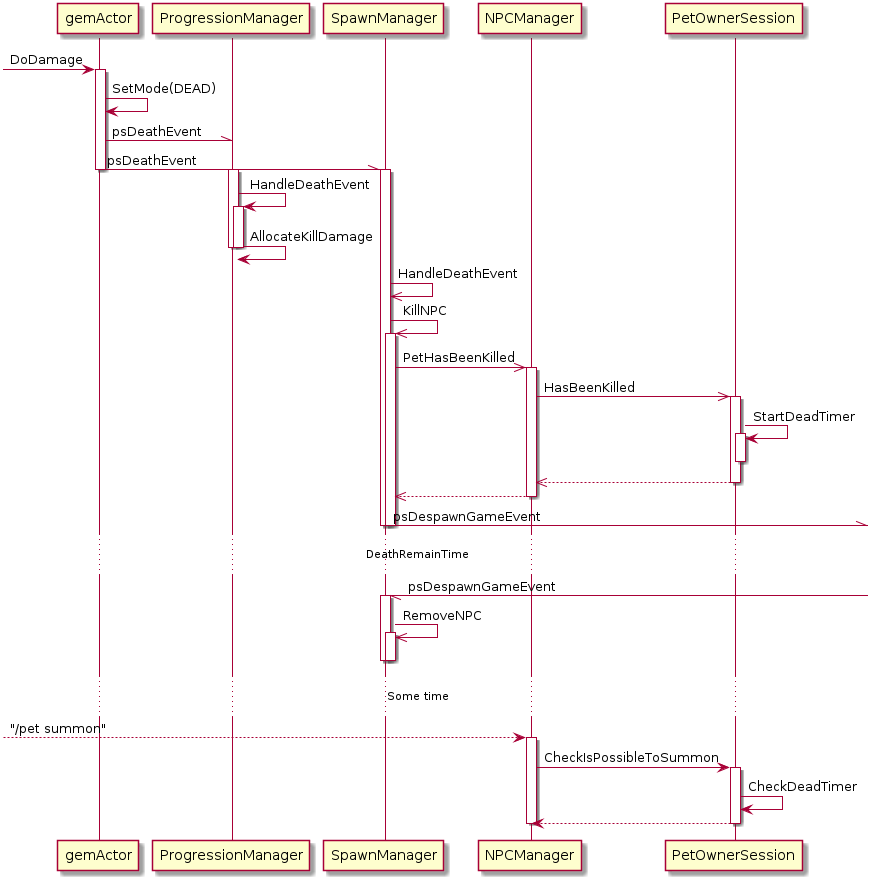
PSUnreal
Ideas for Pets
Specific new information needed, will be stored in character_variables table associated to the pet:
- Energy
- Happiness
- Last time fed
Other fields used, but already available in the current database structure:
- Exp (available)
- Inventory (available)
- Knowledge area to speak (available)
For the Pet evolution and associated abilities we need to add two new tables:
- Pet Evolution table: ID, Name, size_scale, mesh_name, exp_required
- Pet Abilities table: evo_stage_id, name, pet_command, storage
where pet_command will determine access from the player to the specific command in the list below:
/pet learn location forest /pet learn target Trepor /pet go location forest /pet go position 100 f /pet learn phrase Hello my name is... /pet learn answer "what is your name" "my name is xyz" /pet scout creatures <range?> /pet scout items <range> /pet grant yes/no <name> /pet scout traps <range?> /pet scout hidden <range?> /pet distract <target> /pet senses sight
To evolve your pet, you will give him food, which is providing energy, energy allows to execute tasks/abilities, this is increase the experience of the pet and the empathy of the owner, and at certain level of experience the pet evolves to a new stage.
Food -> Energy -> Abilities -> Exp/Empathy -> Evolution stage